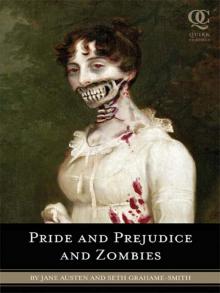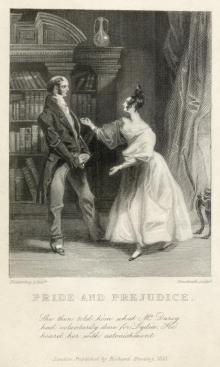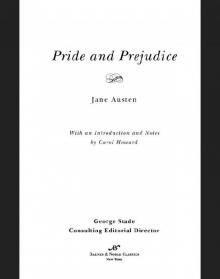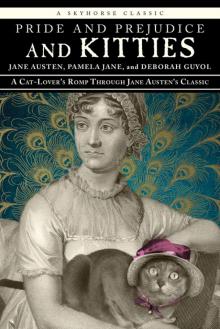- Home
- Jane Austen
Oxford World’s Classics Page 5
Oxford World’s Classics Read online
Page 5
41 ‘Biographical Notice of the Author’ (1818), in Austen-Leigh, Memoir, 137.
42 Elegant Extracts: or useful and entertaining Passages in Prose (London: Charles Dilly, n.d.), an anthology much in use in late eighteenth-century schoolrooms. The Austen family copy, inscribed to Anna, ‘the gift of her Aunt Jane’, is now in Jane Austen’s House Museum, Chawton.
43 Alexander Pope, The Rape of the Lock. An Heroi-Comical Poem (London, 1714), canto 1, line 2.
44 Pope, Rape of the Lock, canto 1, line 138.
45 Pope, Rape of the Lock, canto 3, line 8.
46 Austen-Leigh, Memoir, 141. Austen was born in 1775; Johnson died in 1784.
47 Samuel Johnson, Rambler no. 29 (1750), in The Rambler, 6 vols. (London, 1752), i, 254.
48 See OED, ‘bathos’, sense 2.
49 Samuel Johnson, A Journey to the Western Islands of Scotland (London, 1775), 61.
50 Letters, 23 (to Cassandra Austen, 25 Nov. 1798).
51 See also Freya Johnston, ‘Johnson and Austen’, in Greg Clingham and Philip Smallwood (eds.), Samuel Johnson After 300 Years (Cambridge: Cambridge University Press, 2009), 225–45.
52 ‘So much for Mrs Piozzi.—I had some thoughts of writing the whole of my letter in her stile, but I believe I shall not’ (Letters, 46, to Cassandra Austen, 11 June 1799); ‘ “But all this, as my dear Mrs Piozzi says, is flight & fancy & nonsense—for my Master has his great Casks to mind, & I have my little Children”’ ’ (Letters, 162, to Cassandra Austen, 9 Dec. 1808).
Chronology of the Teenage Writings
Titles are as they appear on the Contents page of each volume of the notebooks; dates and other annotations in italics within the parentheses are those provided by Jane Austen.
Volume the First
1787–90 ‘Frederic & Elfrida’, ‘Jack & Alice’, ‘Edgar & Emma’, ‘Henry & Eliza’, ‘Mr Harley’, ‘Sir William Mountague’, ‘Mr Clifford’, ‘The beautifull Cassandra’, ‘Amelia Webster’, ‘The Visit’, ‘The Mystery’
The first eleven items are the earliest written and in most cases cannot be dated more precisely.
‘Jack & Alice’ and ‘Mr Harley’ are dedicated to JA’s fifth brother, Francis, ‘Midshipman on board his Magesty’s ship the Perseverance’; Francis Austen held this rank on HMS Perseverance from December 1789 to November 1791, but since the dedications were inserted after the inscription of the tales, these dates can be no precise guide to either composition or inscription.
‘Henry & Eliza’ may date from December 1787 or 1788, when Henry, JA’s fourth brother, and their cousin Eliza de Feuillide were involved together in family theatricals at Steventon.
‘Sir William Mountague’ may be dated to late 1788. In that year 1 September fell on a Monday, which coincides with a reference in the text to ‘Monday … the first of September’.
‘The beautifull Cassandra’ may be dated after summer 1788, when Mr and Mrs Austen took JA and Cassandra on a trip to London and Kent. The story is set in central London.
‘The Visit’ must post-date June 1789, as it is dedicated to ‘the Revd James Austen’, JA’s eldest brother, who was ordained priest in that month.
Volume the Second
1790 ‘Love and Friendship’ (dated at the end: June 13th1790)
The date is the earliest given by JA in the notebooks, though several writings in Volume the First clearly pre-date 1790. JA deleted ‘Sunday’ before the date, ‘June 13th’, though 13 June did fall on a Sunday in 1790.
1791 ‘The History of England’ (dated at the end: Saturday Nov: 26th 1791)
Volume the First
1791 ‘The three Sisters’
‘The three Sisters’ may date from December 1791, when JA’s third brother, Edward, to whom the story is dedicated, married one of three sisters.
Volume the Second
1792 ‘Lesley-Castle’ (letters in the story are dated from Janry 3d 1792 to April 13th [1792])
Henry Austen, JA’s fourth brother, took his BA at Oxford in spring 1792. JA may have dedicated this tale to him in order to mark the occasion.
‘Collection of Letters’
The letters may date to autumn 1792, when Jane Cooper, their dedicatee, was staying at Steventon and before her marriage that December.
Volume the Third
1792 (contents page signed and dated: May 6th 1792)
‘Evelyn’
‘Kitty, or the Bower’ (dedication dated: August 1792)
Volume the Second
1793 (early) ‘Scraps’
These are dedicated to JA’s niece Fanny Catherine Austen, the daughter of JA’s third brother, Edward, and his wife, Elizabeth Bridges. Fanny was born 23 January 1793.
Volume the First
1793 ‘Detached peices’ (dedication dated: June 2d 1793)
The dedicatee—another niece, Jane Anna Elizabeth Austen, the daughter of JA’s eldest brother, James, and his wife, Anne Mathew—was born 15 April 1793.
‘Ode to Pity’ (annotated at the end End of the first volume. June 3d 1793)
Note on the text
Unlike modern editions of Jane Austen’s famous six novels, which are prepared from printed texts issued in or soon after her lifetime, editions of her teenage writings are based on unique copies of manuscript versions in her own hand: Volume the First, in the Bodleian Library, Oxford (MS Don. e.7), and Volume the Second and Volume the Third, in the British Library, London (respectively Add. MS 59874 and Add. MS 65381). In fact, all the works collected here were left unpublished at Austen’s death in 1817 and therefore derive directly from handwritten sources. Printed editions of the teenage writings began to be issued only in the twentieth century. (For a list of the major editions, see ‘Editions’ in the Select Bibliography.) Modern editors, therefore, can choose either to follow the textual choices made by previous editors in transforming manuscript into print or, like us, to turn afresh to the original manuscript forms and make new decisions on how far to attempt to retain the trace of the written hand, recognizing of course that this is not always possible. Handwriting, unlike print, accommodates itself to individual mechanical quirks—of hand and pen; it can even seem a window onto the personality of the writer; and it changes over time. Since, in her teenage writings especially, Austen paid arch attention to the act of writing itself and to its differences from print, it seems desirable to try to represent those distinctive features that print might suppress or regularize but which appear to enrich her manuscript texts meaningfully. This, of course, is a matter of interpretation over which different editors will reach different decisions.
For this new edition, no changes have been made to Austen’s spellings, capitalization, paragraphing, or punctuation, all features that stamp her writings as her own or of her time. We have preserved Austen’s characteristic use of capitalized initial letters for common nouns occurring in mid-sentence, a use that extends in some cases to adjectives. Capitalizations of this kind are sprinkled liberally across all her manuscript pages from Volume the First to Sanditon, the novel she was writing in 1817 in the last months of her life. But she was by no means consistent in her practice: sometimes in a single sentence the initial letter of one common noun is capitalized and another is not; and where initial letters often hover ambiguously between what print must determine as either upper-case (capital) or lower-case forms, editors must interpret the evidence one way or the other. This shifting between capitalization and non-capitalization gives a slightly irregular and more expressive feel to the text when translated into print. The long-tailed ‘s’, still in use in the handwriting of Austen’s contemporaries (William Wordsworth and John Keats, for example), contributes nothing to meaning and might merely impede the enjoyment of the modern reader; we have therefore taken the decision not to retain it.
By contrast, and in a departure from other modern editions, we have retained Austen’s use of ampersand (&) as a variation upon ‘and’. Ampersands are sprinkled liberally over Volume the First and Volume the Second in partic
ular, acting as the connector of choice for the truncations, distortions, and elisions of the many teasing and frantic performances that make up these two anthologies. The clear preference for ‘and’ in Volume the Third, especially in linking phrases and clauses, reads like a change of pace—a sign, like the lengthier paragraphs, that Austen’s writing is striding out—and the measure of a new belief in her imaginative stamina to sustain a story. By regularly expanding ‘&’ to ‘and’ in print versions of all three notebooks, previous editors of the teenage writings have suppressed what we believe is a significant distinction between the two uses. We have also retained other contractions and abbreviations, such as ‘Compts’ for ‘Compliments’, ‘Capt.’ for ‘Captain’, as contributing to the air of naturalism and even colloquialism achieved by several of the texts collected here. In abbreviations, Austen, like her contemporaries, used raised final letters, writing ‘Mr’, ‘Mrs’, ‘Revd’, and ‘St’, which we represent as ‘Mr’, ‘Mrs’, ‘Revd’, ‘St’; but we have preserved her use of raised letters in some instance, like ‘Esqre’, ‘1st’.
Austen’s floating or absent apostrophes in the so-called Saxon genitive, ‘its’ ’ / ‘it’s’, and the contracted forms ‘sha’nt’ / ‘shan’t’ / ‘shant’, ‘wo’nt’ / ‘won’t’/ ‘wont’ are a challenge; they also seem, like the variations in her spelling (for which see Note on Spelling), peculiarly characteristic of her style, though unlike her distinctive spellings they probably represent no more than a kind of casualness or carelessness in pointing her text. Where she does not include an apostrophe (‘shant’, ‘wont’), we do not supply it. Elsewhere, we have regularized her floating apostrophe to the modern standard (‘shan’t’, ‘won’t’). There are major differences between Austen’s paratactic punctuation (with its resemblance to the pauses made by the speaking voice) and the syntactic punctuation of twenty-first-century printed prose. We have resisted intervening to ‘correct’ what is merely different, most notably by not peppering the pages with those extra commas that the modern reader has come to expect but which are not there in Austen’s text. In her day, for example, conventions for recording direct speech in novels were still experimental and slightly different from modern usage. Austen’s own treatment of written speech changes from item to item within the teenage notebooks, and we have respected and reproduced those differences. So, while we have standardized her double quotation marks around speeches to single, in line with modern British style, we have retained the normal late eighteenth-century conventions of either not marking off the speaker from her spoken words or, on occasion, setting brackets around a speaker’s name; in this we have followed precisely the various systems Austen herself sets in play, intruding into the text in only a very few instances to insert opening or closing quotation marks where they have been accidentally omitted. We do not believe that Austen’s lighter punctuation (a feature of print, too, at that time) will confuse the reader. On the other hand, it will give the modern reader a better sense of the young writer’s use of her notebooks as a trial ground for presenting her work. One particular punctuation mark is worth notice since it is not reproducible in print: that is her occasional combination of an exclamation mark with a comma or semi-colon, piling the two on top of each other; the printed edition can render these only serially, as ‘!;’ or ‘!,’.
One of the most distinctive aspects of the teenage notebooks is their mimicry of bibliographic or print conventions: these are mock books, in which the apprentice author can be seen relishing her experiments with layout and mise en page and imitating what she finds in the volumes she is reading—presentational features as well as subject matter and language—whether they be anthologies of elegant extracts suitable for young ladies or the latest pulp fiction. Austen’s borrowed or parodied formatting features include the layout of dedications, printer’s rules that mark off titles and chapter numbers, conventions for setting out letters, and the representation of dramatic dialogue and of conversations in novels, like the use of running inverted commas down the side of the page to punctuate speech (for example, in ‘Jack & Alice’)—a typographic convention in novels of sensibility in the late eighteenth century.1 We believe that these display features contribute meaningfully to Austen’s stories and constitute a significant aspect of her purpose in the teenage notebooks; our edition accordingly restores many that have slipped from other modern editions or tries to find print equivalents to give the reader a flavour of the visual appearance of the notebooks.
In presenting this new edition of the manuscript materials we have made the following minor decisions: words and phrases underlined for emphasis are printed in italics; we have reduced paragraph indentations to a single length and restricted the range of the dash (Austen uses many different lengths for both); within each story or short work, we have standardized chapter and letter numbers to the most common form (for example, where Austen may within a single piece write on one occasion ‘Chapter the First’ and on another ‘Chapter the second’, or ‘Letter the first’ and ‘Letter the Second’); we have left as they occur within the text any slight differences in the spelling of names of characters (hence, on p. 28 the reader finds ‘Mrs Willson’ and ‘Mrs Wilson’, and on p. 29 ‘Lady Hariet’ and ‘Lady Harriet’, and on p. 103 the ‘Lutterell’ sisters but on p. 106 the ‘Luttrell’ sisters) since they do not impede the reader’s comprehension, and are an aspect of Austen’s swift or careless style that marks her earliest and latest writings. All Austen’s revisions, deletions, and additions are recorded in the Textual Notes at the end of the volume. This edition is based upon work undertaken for the digital edition of Jane Austen’s fiction manuscripts published electronically in 2010. Through digitization, many new readings have been recovered. The reader interested in testing our readings, in inspecting how Jane Austen worked, and in comparing the actual manuscripts with our print interpretations can do so at
Finally, previous editors have attributed to changes in Jane Austen’s hand over time some revisions in the teenage notebooks (specifically in ‘Kitty, or the Bower’ in Volume the Third ) that are, in fact, in the hand of her nephew James Edward Austen. For argument and evidence, we refer readers to the Introduction and the appropriate places in the Textual Notes.
1 See Vivienne Mylne, ‘The Punctuation of Dialogue in Eighteenth-Century French and English Fiction’, The Library, 6th series, 1 (1979), 43–61.
Note on Spelling
While spelling in printed texts exhibited greater stability from the later eighteenth century, the same did not hold for the written language, and especially not for forms unintended for publication, where there could be significant divergence between public and private usage, between print and manuscript. Even among educated people of the period, spelling continued to retain, like handwriting itself, a more expressive and individual stamp. In these circumstances, variations in the appearance of a word, between different authors or between different works by the same author, and even within a single document, should not be viewed as incorrect.1
Jane Austen’s spelling requires no apology or excuse; no serious editor since Victorian times has attempted to amend it. At the same time, it carries for the modern reader the stamp of her personality; variations in her spelling within manuscripts, between manuscripts over time, and in revision may be significant. Variation may suggest a timescale within which certain pieces were written or revised, or it may point to the introduction of a different hand and thus offer evidence for reattribution, as we argue is the case in the revision of ‘Kitty, or the Bower’ in Volume the Third, with its different spellings ‘Catherine’ / ‘Catharine’ and ‘amiable’ / ‘aimiable’.
Because non-standard spelling is among the effects contributing to the reader’s enjoyment of the resistant texture of Jane Austen’s teenage writings—their flavour of anarchy or disconnection from a norm— it is tempting, but probably wrong, to argue that this was part of the writer’s intention. Her various attempts to name Sir Arthu
r Hampton in the short play ‘The Visit’ (Volume the First) appear at first sight to pun upon similarities, to eye and ear, between ‘Author’ and ‘Arthur’ (pp. 44, 224). But it is more likely that the confusion is a clue to Austen’s pronunciation, with ‘Author’ sounding in her Hampshire accent not unlike ‘Arthur’, and so ‘Author’, a word she gleefully inscribes as often as possible in these early works, instructed her in how to spell ‘Arthur’: she originally wrote ‘Sir Author’ and (several times) ‘Authur’, though on each occasion she corrected the text to the conventional spelling.
The use and disappearance, or even replacement, across the teenage notebooks of some characteristic variant forms may be a clue to dating. For example, at the beginning of Volume the First Austen wrote ‘extream’ (p. 20) and ‘extreamly’ (pp. 26, 45), but by the time, several years later, that she inscribed ‘The three Sisters’ into its pages, she wrote ‘extremely’ (pp. 52 and 55), and ‘extreme’ / ‘extremely’ remain her standard spelling thereafter. Moreover, at some point she returned to p. 26 to alter ‘extreamly’ to ‘extremely’, though the spellings at p. 20 and p. 45 remain unchanged. Similarly, the forms ‘compleat’, ‘compleatly’, and ‘compleated’ figure prominently in the earlier sections of Volume the First (pp. 20, 23, 37, 38), with the shift to ‘completed’ at ‘The three Sisters’ (p. 59). But ‘compleat’ is in use in ‘Love and Friendship’ in the early pages of Volume the Second (pp. 79, 81), to be replaced by ‘complete’ at p. 135 (in ‘Collection of Letters’), and this remains her spelling through the subsequent fiction manuscripts. It offers a tiny further clue, if we needed it, that ‘The three Sisters’ was inscribed into Volume the First after ‘Love and Friendship’ into Volume the Second.

 Sense and Sensibility
Sense and Sensibility Persuasion
Persuasion Mansfield Park
Mansfield Park Northanger Abbey
Northanger Abbey Pride and Prejudice and Zombies
Pride and Prejudice and Zombies Pride and Prejudice
Pride and Prejudice Emma
Emma Persuasion (Dover Thrift Editions)
Persuasion (Dover Thrift Editions) Lady Susan
Lady Susan Northanger Abbey (Barnes & Noble Classics)
Northanger Abbey (Barnes & Noble Classics) Lady Susan, the Watsons, Sanditon
Lady Susan, the Watsons, Sanditon Darcy Swipes Left
Darcy Swipes Left Persuasion: Jane Austen (The Complete Works)
Persuasion: Jane Austen (The Complete Works) Mansfield Park (Barnes & Noble Classics Series)
Mansfield Park (Barnes & Noble Classics Series) Sense and Sensibility (Barnes & Noble Classics Series)
Sense and Sensibility (Barnes & Noble Classics Series) The Annotated Sense and Sensibility
The Annotated Sense and Sensibility Pride and Prejudice (Clandestine Classics)
Pride and Prejudice (Clandestine Classics) Persuasion (AmazonClassics Edition)
Persuasion (AmazonClassics Edition) Persuasion (Barnes & Noble Classics Series)
Persuasion (Barnes & Noble Classics Series) Complete Works of Jane Austen
Complete Works of Jane Austen The Watsons and Emma Watson
The Watsons and Emma Watson Northanger Abbey and Angels and Dragons
Northanger Abbey and Angels and Dragons Love and Friendship and Other Early Works
Love and Friendship and Other Early Works Emma (Barnes & Noble Classics Series)
Emma (Barnes & Noble Classics Series) Sanditon
Sanditon Pride and Prejudice (Barnes & Noble Classics Series)
Pride and Prejudice (Barnes & Noble Classics Series) Pride and Prejudice and Kitties
Pride and Prejudice and Kitties The Annotated Northanger Abbey
The Annotated Northanger Abbey Oxford World’s Classics
Oxford World’s Classics Northanger Abbey (Barnes & Noble Classics Series)
Northanger Abbey (Barnes & Noble Classics Series) The Annotated Persuasion
The Annotated Persuasion Emma (AmazonClassics Edition)
Emma (AmazonClassics Edition) The Annotated Emma
The Annotated Emma The Annotated Mansfield Park
The Annotated Mansfield Park The Annotated Pride and Prejudice
The Annotated Pride and Prejudice